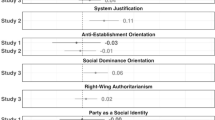Abstract
This paper considers the division of a public budget among competing interests. The planner determines the optimal allocation by maximizing a weighted social welfare function. These weights reflect society's attitudes to different recipient groups, and are not constrained to be constant. By exerting “pressure”, the recipients can attempt to manipulate the weights and hence influence the division of the budget. The amount of resources used on pressure, and the effects on the preference weights are calculated. An important parameter in the model is the elasticity of pressure, for which an appropriate estimate is presented from the case of competition for a share of a health services budget in Norway.
Similar content being viewed by others
References
Becker, G.S. (1983). A theory of competition among pressure groups for political influence. Quarterly Journal of Economics 98: 371-400.
Clark, D.J. and Riis, C. (1996). On the win probability in rent-seeking games. Discussion Paper in Economics No. E4/96, University of Tromsø, Norway.
Culyer, A.J. (1990). Commodities, characteristics of commodities, characteristics of people, utilities and the quality of life. In S. Baldwin et al. (Eds.), The quality of life: Perspectives and policies. London: Routledge.
Culyer, A.J. (1991). Health, health expenditures and equity. University of York, Centre of Health Economics, Discussion Paper 83.
Katz, E., Nitzan, S. and Rosenberg, J. (1990). Rent-seeking for pure public goods. Public Choice 65: 49-60.
Magee, S.P., Brock, W.A. and Young, L. (1989). Black hole tariffs and endogenous policy theory. Cambridge, MA: Cambridge University Press.
Nitzan, S. (1994). Modelling rent-seeking contests. European Journal of Political Economy 10: 41-60.
Olsen, J.A. (1996). Theories of justice and their implications for priority setting in health care. Journal of Health Economics, forthcoming.
Pedersen, K.R. (1995). Rent-seeking, political influence and inequality: A simple analytical example. Public Choice 82: 281-305.
Snyder, J.M. (1989). Election goals and the allocation of campaign resources. Econometrica 57: 637-660.
Torrance, G.W. (1986). Measurement of health state utilities for economic appraisal. Journal of Health Economics 5: 1-30.
Tullock, G. (1980). Efficient rent-seeking. In J.M. Buchanan, R.D. Tollison and G. Tullock (Eds.), Toward a theory of the rent-seeking society. College Station: Texas A&M Press.
Tullock, G. (1995). The reluctant gamesperson. Public Choice 85: 189-192.
Wagstaff, A. (1991). QALYs and the equity-efficient trade-off. Journal of Health Economics 10: 21-41.
Williams, A. (1988). Ethics and efficiency in the provision of health care. In M. Bell and S. Mendus (Eds.), Philosophy and medical welfare. Cambridge, MA: Cambridge University Press.
Author information
Authors and Affiliations
Rights and permissions
About this article
Cite this article
Clark, D.J. Pressure and the division of a public budget. Public Choice 93, 179–195 (1997). https://doi.org/10.1023/A:1004999118758
Issue Date:
DOI: https://doi.org/10.1023/A:1004999118758




